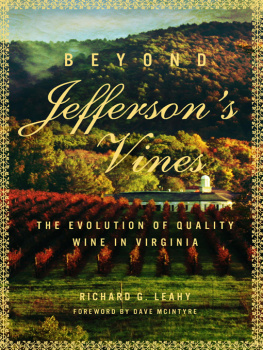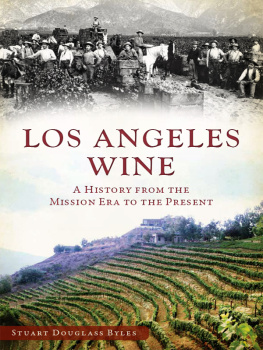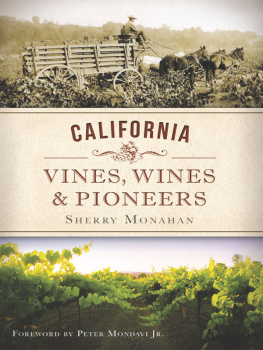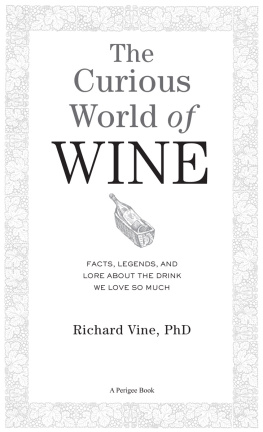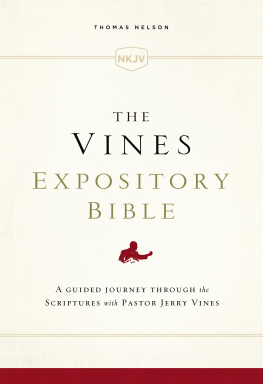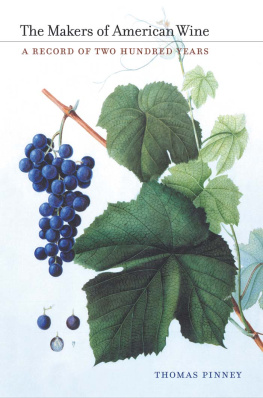Thomas Pinney - The City of Vines; A History of Wine in Los Angeles
Here you can read online Thomas Pinney - The City of Vines; A History of Wine in Los Angeles full text of the book (entire story) in english for free. Download pdf and epub, get meaning, cover and reviews about this ebook. genre: Detective and thriller. Description of the work, (preface) as well as reviews are available. Best literature library LitArk.com created for fans of good reading and offers a wide selection of genres:
Romance novel
Science fiction
Adventure
Detective
Science
History
Home and family
Prose
Art
Politics
Computer
Non-fiction
Religion
Business
Children
Humor
Choose a favorite category and find really read worthwhile books. Enjoy immersion in the world of imagination, feel the emotions of the characters or learn something new for yourself, make an fascinating discovery.
- Book:The City of Vines; A History of Wine in Los Angeles
- Author:
- Genre:
- Rating:4 / 5
- Favourites:Add to favourites
- Your mark:
- 80
- 1
- 2
- 3
- 4
- 5
The City of Vines; A History of Wine in Los Angeles: summary, description and annotation
We offer to read an annotation, description, summary or preface (depends on what the author of the book "The City of Vines; A History of Wine in Los Angeles" wrote himself). If you haven't found the necessary information about the book — write in the comments, we will try to find it.
Thomas Pinney: author's other books
Who wrote The City of Vines; A History of Wine in Los Angeles? Find out the surname, the name of the author of the book and a list of all author's works by series.
The City of Vines; A History of Wine in Los Angeles — read online for free the complete book (whole text) full work
Below is the text of the book, divided by pages. System saving the place of the last page read, allows you to conveniently read the book "The City of Vines; A History of Wine in Los Angeles" online for free, without having to search again every time where you left off. Put a bookmark, and you can go to the page where you finished reading at any time.
Font size:
Interval:
Bookmark:

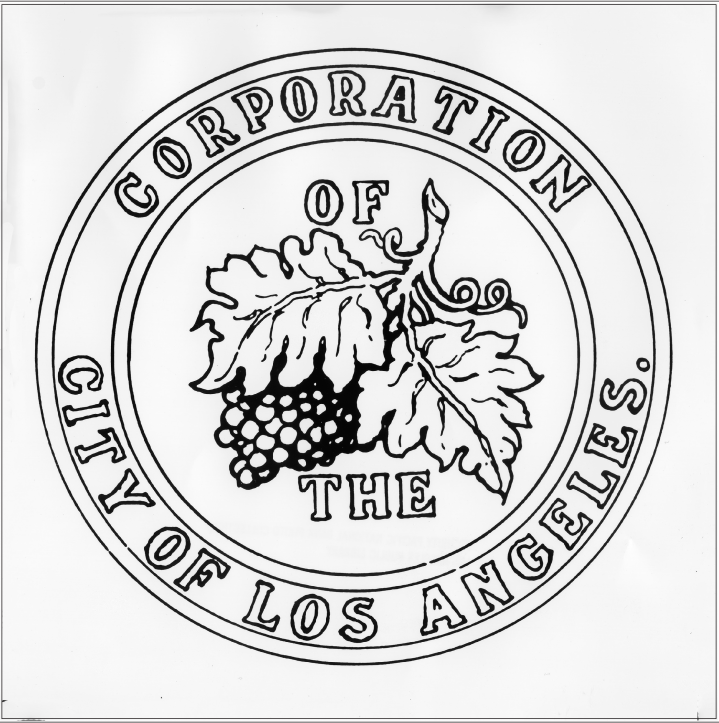
The original seal of Los Angeles, in use from 1854 to 1905, identifying it as the City of Vines. Courtesy of the Los Angeles Public Library.

The publisher is grateful to the Wine Librarians Association for its generous support of this project.
2017 by Thomas Pinney
All rights reserved. No portion of this work may be reproduced or transmitted in any form or by any means, electronic or mechanical, including photocopying and recording, or by any information storage or retrieval system, without permission in writing from Heyday.
Library of Congress Cataloging-in-Publication Data
Names: Pinney, Thomas, author.
Title: The city of vines : a history of wine in Los Angeles / Thomas Pinney.
Description: Berkeley, California : Heyday ; San Francisco, California : California Historical Society, [2017] | Includes bibliographical references and index.
Identifiers: LCCN 2016047274 | ISBN 9781597143981 (hardcover : alk. paper)
Subjects: LCSH: Wine industry--California--Los Angeles--History.
Classification: LCC HD9378.L67 P56 2017 | DDC 338.4/7663200979494--dc23
LC record available at https://lccn.loc.gov/2016047274
Cover Art: Workers in the vineyards of the Sierra Madre Vintage Company. Courtesy of the California Historical Society at the University of Southern California.
Cover and Interior Design/Typesetting: Ashley Ingram
Printed in East Peoria, IL, by Versa Press, Inc.
Orders, inquiries, and correspondence should be addressed to:
Heyday
P.O. Box 9145, Berkeley, CA 94709
(510) 549-3564, Fax (510) 549-1889
www.heydaybooks.com
10 9 8 7 6 5 4 3 2 1 |
To Catharine Alexander
![]()
The most striking fact about the history of winemaking in Los Angeles, city and county, is the completeness with which it has been forgotten. The trade has left hardly any material traces. If any buildings survive, they have been converted to other purposes so that their origins are unrecognizable, and the vineyards themselves have long since been swept away under the tide of housing. No one writes about the tradition of Los Angeles winemaking, few local histories make anything of the subject, and most people have no idea that the region was once the main source of California wine. When I tell people that I am writing about winemaking in Los Angeles, the invariable response is one of skeptical surprise: Whoever heard of that? And what can I find to write about?
Yet Los Angeles is where it all began, and where, for years, the main action was to be found. California wine meant Los Angeles wine. The whole California wine establishment descends directly from Los Angeles, and long after Los Angeles, city and county, had been outpaced as a player in California winemaking, it continued to be important.
My focus on the city and county of Los Angeles may seem an arbitrary limitationwhy not write about all of Southern California? The fact is, nothing elsewhere compared in importance to Los Angeles. Until the turn of the twentieth century, the city and county of Los Angeles provided, overwhelmingly, the winemaking in Southern California. There were scattered growers and producers in Santa Barbara, Ventura, and San Diego Counties, but nothing to signify. San Bernardino County, now imagined by most people to have been the major source of Southern California wine, did not in fact develop until the vineyards were beginning to be crowded out of L.A. County, and then it did so as a colonial development of the big Los Angeles wineries. The substantial vineyards in and around Rancho Cucamonga persisted into the 1960s, which is why people now think of the region as primary.
These two facts are why I have written this book: the fact that it was important, and the fact that it has been forgotten. I have enjoyed the work of putting together the case for giving Los Angeles its due. There is no doubt much more that might be known, but I have at least made a beginning.
That the missions made wine is generally known, but our information about how it was made, and how much of it was made, and what was done with it when it was made, is terribly thin. No one, so far as I know, has studied the question with any thoroughness. I have not been able to add anything to the subject; a patient study of the Spanish records would be required, and I am not competent to do that. There is a fair amount of information about the brief Mexican period, and after the American takeover in 184647 the record becomes reasonably full. I have, accordingly, given most of my attention to the hundred years following the American conquest down to the end of the story in the 1950s.
My two major sources are, first, the Huntington Library and, next, the Shields Library of the University of California, Davis. The Huntington houses a rich collection of material from Southern California in the nineteenth century: the papers of Benjamin D. Wilson, of J. DeBarth Shorb, of L. J. Rose, and others provide a detailed view of the scene at the time. At Davis, the great librarydeveloped to support the universitys work in viticulture and enology, and now presided over by my former student Axel Borgwas an essential source of information, as were the records of the Bureau of Alcohol, Tobacco, and Firearms (BATF), the federal agency concerned with winemaking, now held in Special Collections at the Shields Library. The history of Los Angeles wine under Prohibition and in the years following Repeal would be impossible to write without the BATF papers.
Of the published work about Southern California winemaking, by far the most substantial and useful is Ernest Peninous posthumously published History of the Los Angeles Viticultural District (2004). Charles Sullivans series of articles about early California winemaking, published in the Wayward Tendrils Quarterly from April 2010 to October 2015, is another invaluable source of information, notable for its fullness and accuracy. Two exemplary works of reference were constantly useful: James D. Harts Companion to California (1987) and Leonard Pitt and Dale Pitts Los Angeles A to Z: An Encyclopedia of the City and County (1997); both volumes were published by the University of California Press.
A special word should be said about the collection devoted to the history of winegrowing in Southern California, held at California State Polytechnic University, Pomona, and developed under the direction of Danette Cook Adamson. It takes a broad view of history and is now a rich and growing collection not only of documents but of labels, posters, brochures, photographs, bottles, winemaking equipment, and other things associated with wines and vines as they flourished in Southern California.
Two friends, Gail Unzelman and Charles Sullivan, have, as always, provided indispensable help.
In May of 1769 the men and animals of the so-called Sacred Expedition were gathered near Loreto, on the Baja peninsula of Mexico, poised to begin their march into what is now California. Some four hundred cattle had already been driven northward by a group in advance of the main expedition, which was under the command of Captain Gaspar de Portol. Another group had been sent around by sea and were to rendezvous with the overland marchers at San Diego Bay. The object of the expedition was to establish a Spanish presence in what, except for its coastline, was an almost wholly unexplored region stretching for hundreds of miles to the north along the Pacific. The expedition was called Sacred because the soldiers who provided the muscle were accompanied by Franciscan priests, whose charge was to set up missions, convert the Indians, and so prepare the land for productive settlement. The political meaning of the expedition was to forestall any occupation of the land by foreign powersnotably the Russians, who had made tentative moves in that direction, but also the English, who had a base in Canada from which they could move southward. When the expedition began its march north, the modern history of California began, and with it the history of winemaking in Californiaalthough not all at once.
Next pageFont size:
Interval:
Bookmark:
Similar books «The City of Vines; A History of Wine in Los Angeles»
Look at similar books to The City of Vines; A History of Wine in Los Angeles. We have selected literature similar in name and meaning in the hope of providing readers with more options to find new, interesting, not yet read works.
Discussion, reviews of the book The City of Vines; A History of Wine in Los Angeles and just readers' own opinions. Leave your comments, write what you think about the work, its meaning or the main characters. Specify what exactly you liked and what you didn't like, and why you think so.



